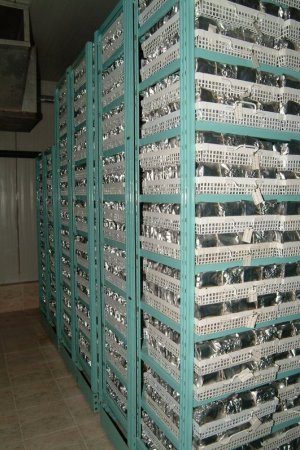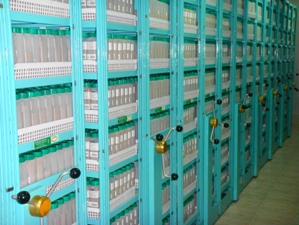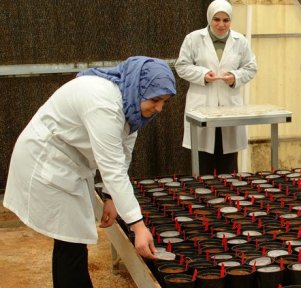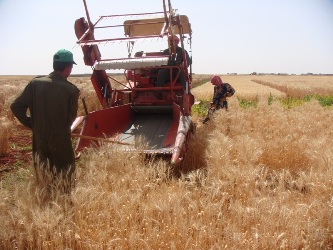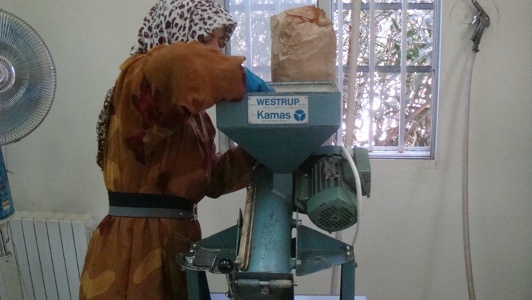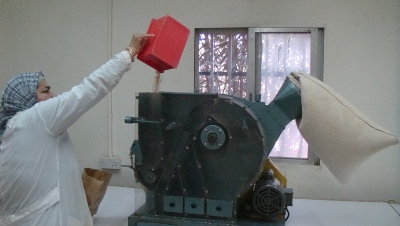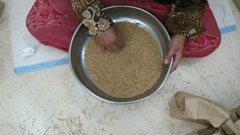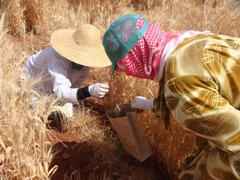Barley
Distribution of cultivated barley and wild relatives genetic resources
Contributors to this page: ICARDA, Syria (Ahmed Amri, Bilal Humeid, Kenneth Street, Natalya Rukhkyan, Jan Konopka, Siham Asaad, Adnan Omran and Fida Alô).
|
Contents: |
Policies and regulations for distribution
Common policies on distribution and access to plant material
- Germplasm should be distributed free of charge in response to official requests by letter or e-mail.
- Requests by phone should not be accepted.
- A Standard Material Transfer Agreement (SMTA) should be used with every shipment.
Policy exceptions
- No exceptions – a written request should be obligatory, as is the use of the SMTA.
National laws and regulations
It is essential to follow the terms and conditions in the host country agreements.
- Phytosanitary certificate.
- Letter of donation (with no commercial value).
- Certificate of origin.
- GMO-free certificate.
- Import permit.
International laws and regulations
- Any seed shipment should be sent with the SMTA (this is an international regulation).
Phytosanitary regulations
- Phytosanitary certificate (to avoid the danger of introducing pests and diseases into new areas).
- Certificate of origin.
- GMO-free certificate (to confirm that the sample is free from GMOs).
User related issues for distribution
Feedback to users
- Requests should be handled within 3-5 weeks (from registration of the request to dispatching the seeds).
Customer assurance
Recommended procedures that ensure the material distributed matches the client request. It is very important that records are kept and that there is an information feedback.
- All requests should be checked and validated by the crop curator (to make sure that records are kept and there is information feedback).
- When the customer requests specific germplasm giving referencing identification numbers, the original request should be transferred to the curator who checks availability before passing the genebank distribution request to the genebank manager. The list of accessions provided by the curator should be checked against the distribution list - this is to increase the probability that the subset of material sent to the customer contains the sought after traits while keeping the subset to a size which is commensurate with the resources that are available to the customer. Some types of screening are relatively expensive and there will be a limit to what the customer can afford to screen.
- When the customer requests accessions with specific traits, the curator should check the availability based on information in the database and make the selection of accessions.
- Where no data is available, a random sample should be extracted or the core collection should be sent to the customer.
- When the customer approaches the genebank with a request for unreferenced material, it is essential that the customer and the curator discuss the request to clarify what specific traits or adaptations they are looking for.
- Once this is established, the curator can use all the information at his disposal to tailor a set of material that has the best probability of containing the sought after traits in a subset that suites the client.
- For adaptive traits being sought in landrace material and/or wild progenitors, ideally the Focused Identification of Germplasm Strategy (FIGS) is deployed in which geo-referenced material is coupled with information about the environments in which they evolved. This information can then be used to make predictions about what selection pressures may have genetically shaped the material in the collection. Thus this best practice is closely connected with maintaining an up-to-date and well populated data management system in which, ideally, information about the collections sites is detailed and expanded with GIS data layers.
Feedback from users
The most relevant information required to be received from users is as follows:
- Recipients should be requested to return characterization, evaluation and other observations made on the material provided (this helps to identify deficiencies in services and be informed about any valuable traits).
Quantity of material recommended to be distributed
A small quantity of seed should be distributed to keep the active collection seed stocks for longer and hence reduce the regeneration frequency.
- Cultivated barley: 100 seeds.
- Barley wild relatives: 50 seeds.
Check availability
- Verify the request by the curator.
- Register the request by assigning consistent/unique request numbers.
- Check availability of seeds in stock and verify the request accordingly (accessions with low amount of seeds in stock (S Flag) should not be distributed).
- Prepare the SMTA and passport data.
- Send the material out.
Preparing samples for distribution
- Prepare a list of the accessions available.
- Check the requirements for material transfer agreements.
- Generate labels.
- Check inventory files and the location of containers in the genebank.
- Remove containers from genebank following the acclimatization procedures required.
- Assure accuracy in identification.
- Extract samples from the original containers.
- Label the seed packets.
- Update the inventory of genebank (the genebank database should always be kept updated).
Preparing the information list to accompany the plant material
- List of accessions and passport data (e.g. accession number, accession identification, crop name, taxon name, country of origin, biological status, collecting location).
- Standard Material Transfer Agreement (SMTA).
- Cover letter (more passport data could be available upon request).
- Characterization data should be used to verify the accessions (minimum characterization data should be provided upon request if available).
Dispatching the plant material
-
Pack the seeds in paper envelopes, laminated envelopes or nylon bags.
- Then attach the phytosanitary certificate, import permit, GMO-free certificate in a plastic bag and place in a strong envelope or a cardboard box.
- The SMTA and the list, along with copies of all documents, should be put inside the box.
- Label the envelope/box with the complete mailing address of the customer.
- Follow any additional instructions from the customer.
- Sending the plant material: seeds should be sent by fastest means to avoid decline in quality.
- Include a reply form or acknowledgement of seed reception form: the requester should complete and return it to the genebank to acknowledge that seeds have been received in good condition.
- Recording shipping details: shipping details should be recorded in a distribution data file.
Recording Information
Recording information during distribution
The following information must be recorded for each consignment:
- Reference number.
- Crop name.
- Consignee’s name and designation/title.
- Name and address of organization.
- User information (type of organization requesting material).
- Date of request.
- Date of supply.
- Number and quantity of samples provided.
- Reference number of SMTA.
- Intended use.
- Classification of intended germplasm use (for internal reporting and monitoring of pattern of use).
- Remarks.
- Other/miscellaneous information.
System for tracking material/inventory system for distribution
- The genebank documentation system should include a module for distribution.
References and further reading
Rao NK, Hanson J, Dulloo ME, Ghosh K, Nowel D, Larinde M. 2006. Manual of seed handling in genebanks. Handbooks for Genebanks No. 8. Bioversity International, Rome, Italy. Available in English (1.5 MB), Spanish (1.4 MB) and French (1.9 MB).
The International Treaty on Plant Genetic Resources for Food and Agriculture. (Homepage of ITPGRFA) [online]. Available from: http://www.planttreaty.org/. Date accessed: 27 January 2010.
See the Safe Transfer of Germplasm (STOG) section in this website for seed health movement (this is essential to avoid the spread of pests and diseases).
Storage of cultivated barley and wild relatives genetic resources
Contributors to this page: ICARDA, Syria (Ahmed Amri, Bilal Humeid, Kenneth Street, Natalya Rukhkyan, Jan Konopka, Siham Asaad, Adnan Omran and Fida Alô).
|
Contents: |
Base collection
|
The base collection at ICARDA (photo: ICARDA) |
A base collection is a long-term storage. The initial population is used as a bench mark for monitoring changes in genetic diversity over time and after several cycles of regeneration due to genetic drift. It should insure that an accession’s seed viability remains at acceptable levels for at least 50 years, or for at least one regeneration cycle of the accession.
When it should be used
- It should be used to hold seed samples for long-term conservation.
- It should serve as a duplicate and safety collection of the active collection's long-term conservation.
- It must reduce the number of regeneration cycles for the conservation of the genetic integrity of the accessions.
- It should provide the foundation seeds for regeneration of the genebank accessions.
- It should also provide seed samples of the accessions for seed requests and seed exchange, as it conserves all the accessions of the genebank.
- It acts as a black-box seed storage for the safety deposit of the accessions of the cooperative genebanks.
- Its function and operation should be supported in the long term by core or essential funding of the institution or government.
Sample specifications
These are required to choose a representative sample and to avoid genetic drift.
Minimum sample size for storage
- Cultivated barley: two packets of 25 g each.
- Barley wild relatives: one packet of 25 g.
Minimum viability for storage
- Cultivated barley: >90%.
- Barley wild relatives: >80%.
Moisture content
- 5-7% (to avoid any deterioration of the stored seed samples).
Container specifications
Seed packaging method
- Aluminum foil packets sealed under vacuum (these are moisture-proof and occupy less space than other containers).
- Packing is best carried out in an air-conditioned room with controlled humidity, as quickly as possible after drying (to prevent the re-absorption of water).
Specifications of packaging material
-
Aluminum foil packets consisting of the following layers:
- Polyester 17 g/m².
- Alufoil 33 g/m².
- Polyethylene 63 g/m².
Storage specifications
Assigning location codes
- It is preferable to use sliding shelves (for easy access to the accessions).
- Record the position of each accession in the store, e.g. unit/block number, row shelf number, shelf number and tray number.
Storage conditions
- -18 to -22°C (maintains seed viability) in cold walk-in rooms or in freezers (preferably vertical freezers).
Recording information during storage - Base collection
The following information should be recorded for each step:
- Accession number (unique number).
- Weight of the sample (g).
- Estimated number of seeds (estimated from 1000 kernel weight).
- Year of regeneration (date).
- Viability (%).
- Viability test date (date).
- Recommended next viability test date (date).
- Phytosanitary status (approved, conditionally approved, rejected).
- Position of the sample in the storage facility (coordinates).
|
The active collection at ICARDA (photo: ICARDA) |
An active collection consists of accessions that are available for distribution and are accessed frequently. The active collection is intended to preserve germplasm viability in medium-term storage conditions for at least 20 years or for half of one regeneration cycle in the base collection.
When it should be used
- The active collection should be used to hold seed samples for medium-term conservation.
-
The active collection is important to:
- Conserve accessions most actively used or expected to be used such as elite lines and populations, core subsets and reference seed sets of all accessions.
- Distribute seed samples requested by users.
- Store introductions and the regenerated seeds before inventorying them.
Sample specifications
Minimum sample size for storage
- Cultivated barley: 1500 seeds (L flag) (this is a representative sample).
- Wild species: 1500 seeds (L flag).
Viability for storage
- Cultivated barley: > 90%.
- Wild species: > 80%.
Moisture content
- 5-7% (to avoid any deterioration of the stored seed samples).
Container specifications
Seed packaging method
Use permeable plastic containers (this will create the balance between seed moisture content and the ambient relative humidity).
Specifications of packaging material
- Square-based bottles with a screw cap made of pure plastic material (high quality), semi transparent, white in colour, volume (400 ml) (as used at ICARDA). These are moisture resistant and withstand storage at low temperature for a long period of time without cracking or any other physical deterioration.
Storage specifications
Assigning location codes
- It is preferable to use sliding shelves (for easy access to the accessions).
- Record the position of each accession in the store, e.g. unit/block number, row shelf number, shelf number and tray number.
Storage conditions:
- 3 ± 2oC (extends the storage life and breaks any dormancy if present). Relative humidity controlled at 15-20% if seeds are stored in permeable plastic containers.
Recording information during storage - Active collection
The following information should be recorded for each step:
- Accession number.
- Weight of the sample.
- 1000 kernel weight.
- Number of seeds (estimated from weight using 1000 kernels).
- Number of packets.
- Year of production of seeds.
- Viability (%).
- Viability test date.
- Recommended next viability test date.
- Flag for regeneration (Y/N).
- Position of the sample in the storage.
- Flag indicating distribution status (A-available for distribution; L-limited stock; S-stop distribution).
For information on safety duplication in seed banks, click here.
Storage management
Provides guidance on how to arrange the physical space, how to track seed material and record information during storage.
Storage space arrangement
It is very important to provide easy access to the accessions.
Room
- Use the minimum space possible (to reduce the cost of cooling the storeroom), but allow convenient access to each sample.
Shelves
- Sliding shelves should preferably be used (to maximize space between and on the racks in the store and to provide easy access to the accessions).
- Shelves should be spaced slightly higher than the height of the containers.
- Record the position of each accession in the store, e.g. unit/block number, row shelf number, shelf number and tray number.
System for tracking material/inventory system
- It is important to use a database to keep track of stock and location of material, and to use barcodes (databases are needed to keep track of information; barcoding helps to avoid errors in recording).
Recording information during storage
The following information must be recorded for each consignment:
- Accession number (ID number).
- Lot number (ID number).
- Weight of seeds (weight of seeds in store).
- Number of seeds (number of seeds in store).
- Thousand seed weight (weight of 1000 seeds).
- Number of packets (number of containers for seeds of one lot of each accession).
- Location of containers (store, shelf or box number).
- Type of container (material and size of container).
- Year of production of seeds (indicates age of seeds).
- Flag for regeneration (Y/N).
- Flag indicating distribution status (A-available for distribution; L-limited stock; S-stop distribution).
- Year of safety duplication (year).
- Institute holding the duplicate (name of institute holding the safety duplication).
- Location of duplicate sample (box label where the duplicate sample is placed).
References and further reading
Rao NK, Hanson J, Dulloo ME, Ghosh K, Nowel D, Larinde M. 2006. Manual of seed handling in genebanks. Handbooks for Genebanks No. 8. Bioversity International, Rome, Italy. Available in English (1.5 MB), Spanish (1.4 MB) and French (1.9 MB).
Viability of cultivated barley and wild relatives genetic resources
Contributors to this page: ICARDA, Syria (Ahmed Amri, Bilal Humeid, Kenneth Street, Natalya Rukhkyan, Jan Konopka, Siham Asaad, Adnan Omran and Fida Alô).
|
Contents: |
Laboratory methods
Describes the various recommended options, to test the viability and quality of barley seeds. The percentage of germination of the stored seeds of the accessions determines when regeneration of the accessions should take place and if the accession can be distributed to the users.
Type of test
- Standard viability test, following the ISTA method (this one is more accurate, but more seeds are required and hence should be applied when there are enough seeds).
-
Sequential viability test, following the Bioversity International method (this one is less accurate, but requires fewer seeds and hence should be applied in the case of limited number of seeds - See Bioversity's genebank manual No 8).
- This test should be undertaken twice for accuracy.
- If the results are less than the critical value, an additional test should be done.
Number of seeds and replicates
- Standard viability test - 100 seeds and 4 replications (ISTA method).
- Sequential viability test - 10 seeds and 4 replications (Bioversity International method).
Pre-treatment
- Sterilize the seeds using 0.5% solution of sodium hypochlorite for 10 minutes (to avoid any fungi infections).
Media
- Petri dishes, filter papers and tap water.
Temperature
- 20-25oC.
Light
- No specific requirements.
Duration of test
- 5-10 days (most of the seeds germinate within this period).
|
Transplanting germinated seeds to the plastic house (photo: ICARDA) |
Interpretation of results
Following ISTA (2003, 2005) and Association of Seed Analysts (AOSA), 2005:
- For each accession, consider the total number germinated in each replicate.
- Calculate the mean viability percentage of that accession from the results of all replicates.
- If it is above 90%, accept the test as valid. If the result is below 85% (75% for wild species) repeat the test. Calculate the mean viability percentage from the results of the two tests and use this as the overall test result.
- If the results are far below the germination standard, the accession should be sent to regeneration.
- Germination is complete when the seedling can be judged as normal according to specific criteria.
Monitoring intervals
Describes the recommended intervals for different storage conditions.
- After five years of the initial storage, a random sub-sample from stored accessions should be subjected to a new germination test (preferred sequential test) to ensure a high quality of seeds during storage and to meet international standards.
- The results should be compared with the figures from an initial germination test.
- If the results match, the monitoring interval should be expanded.
- If a decline is observed, a larger random seed sample should be re-tested along with checking the storage facilities to avoid any improper conditions and leakages.
Recording information during viability testing
On petri dishes
- Accession number and replication number.
On data sheets and database
- Taxonomic name.
- Number of replications.
- Date started.
- Date ended.
- Temperature.
- Number of seeds (seedlings) germinated in each category (normal, abnormal, non-germinated) (ISTA).
- Germination percentage (counted on normal seedlings only) (seedlings are judged as normal according to specific criteria (ISTA, 2003, 2005; Association of Seed Analysts [AOSA], 2005).
Describes the recommended monitoring methods to assure minimum viability and quantity of seeds in storage.
Methods
- A computerized stock control system should be developed to monitor the quality and quantity of seed accessions in cold store.
To check the quantity
- Flags should be used to show that accessions are available for distribution.
- (L) Low stock: accession is available for distribution but multiplication should be planned.
- (S) Low number of seeds: no distribution should be allowed; sample should be multiplied. Distribution is permitted after multiplication.
To check the viability
- Random samples should be selected for viability testing. The results should be compared with previous viability test results.
- When viability is below the critical value the accession should be planned for regeneration.
- If the current viability is close to critical value, the date for the next test should be set for the following year; if viability is well above the critical value, the date of the next test should be set for five years after the current date.
- In the case of a significant decrease in viability, the genebank facilities should be checked for damage, leakage problems, etc.
Monitoring frequency
Lists the minimum quantity and minimum viability of seeds below which they need to be regenerated.
Critical quantity
- For both cultivated and wild relatives: 1000 seeds (to keep the integrity of the population samples).
Critical germination level
- Cultivated barley: 85%.
- Barley wild relative: 75%.
- Or 10% less than the average value of fresh seeds.
Recording information during routine monitoring
The following information should be recorded for each monitoring step:
- Accession number.
- Date of viability test (update database).
- Germination percentage (update database).
- Date of next test (one year if it is close to critical value; five years when it is above 90%).
- Regeneration flag: (Y – must go for regeneration; N – no need for regeneration).
References and further reading
AOSA (Association of Official Seed Analysts). 2005. Page 113 in: Rules for Testing Seeds (Capashew Ed.), 4-0, 4-11. Las Cruces, New Mexico, U.S.A.
FAO/IPGRI. 1994. Genebank standards. Food and Agriculture Organization of the United Nations, Rome and International Plant Genetic Resources Institute, Rome. Available in English, Spanish, French and Arabic.
ISTA. 2003. International rules for seed testing. International Seed Testing Association, Bassersdorf, Switzerland.
ISTA. 2005. International rules for seed testing. International Seed Testing Association, Bassersdorf, Switzerland.
Health diagnosis of cultivated barley and wild relatives genetic resources
Contributors to this page: ICARDA, Syria (Ahmed Amri, Bilal Humeid, Kenneth Street, Natalya Rukhkyan, Jan Konopka, Siham Asaad, Adnan Omran and Fida Alô).
List of pests and diseases of quarantine importance for barley
Click here for more detailed outputs from the page on the safe transfer of germplasm, on this website.
See also the list of pests and diseases for this crop listed in the crop regeneration guidelines.
Options for testing procedures
- Ustilago nuda (embryo count method).
- Ustilago hordei (seed washing test).
- Pyrenophora graminea (freezing blotter method).
- Xanthomonas translucens pv. undulosa (YDC agar and semi-selective XTS agar).
- Gibberella zeae and Monographella nivalis (freezing blotter method).
- Pyrenophora teres (freezing blotter method, PDA).
- Cochliobolus sativus (freezing blotter method, PDA).
- Barley stripe mosaic virus (ELISA and TBIA [tissue-blot immunoassay]).
Testing intervals/seasons
- Ustilago nuda, Ustilago hordei - Field inspection at flowering stage.
- Pyrenophora gramínea - Field inspection from seedling up to maturity and testing seed after harvest.
- Xanthomonas translucens pv. Undulosa - Field inspection at seedling and heading, and testing seed after harvest.
- Gibberella zeae and Monographella nivalis - Field inspection at maturity stage and testing seed after harvest.
- Pyrenophora teres, Cochliobolus sativus, Barley stripe mosaic virus (BCMV) - Field inspection from seedling to maturity and testing seed after harvest.
Recording information during health diagnosis
The following information should be recorded for each step:
- Accession number.
- Date (of diagnosis).
- Field number (to record the history of field).
- Experiment code or number.
- Plot number.
- Pathogen tested.
- Result of test (using appropriate scoring methods).
References and further reading
Rao NK, Hanson J, Dulloo ME, Ghosh K, Nowel D, Larinde M. 2006. Manual of seed handling in genebanks. Handbooks for Genebanks No. 8. Bioversity International, Rome, Italy. Available in English (1.5 MB), Spanish (1.4 MB) and French (1.9 MB).
Sample processing of cultivated barley and wild relatives genetic resources
Contributors to this page: ICARDA, Syria (Ahmed Amri, Bilal Humeid, Kenneth Street, Natalya Rukhkyan, Jan Konopka, Siham Asaad, Adnan Omran and Fida Alô).
|
Contents: |
Cleaning is the removal of physical contamination from the plant materials after harvest, before they can be stored.
For cultivated barley:
|
|
|
|
|
|
|
|
|
|
|
|
- Harvest and thresh with a plot combine or stationary plot thresher, ensuring that the thresher and combine are clean before proceeding to the next accessions, to avoid any mixture between accessions. Barley seeds are hard and threshing does not cause any physical damage to the seeds, except for hull-less barley which should be threshed gently to avoid damaging the embryos.
- Remove the remaining awns with a di-awner machine.
- Clean with a wind blower separator (to separate the chaff, dust and other inert material from the samples, as well as light and empty seeds).
- Clean with a cylinder-type machine to remove broken seeds (caused by mechanical threshing), diseased seeds, soil particles and stones of the same size and weight of the grains.
- Hand cleaning is advisable as a final stage (to remove contaminants left after machine cleaning e.g. diseased grains).
For barley wild relatives:
- Harvest spikes only by hand (it is common practice to harvest before shattering).
- Remove the remaining awns with a di-awner machine.
- Clean with a wind blower separator (to separate the chaff, dust and other inert material from the samples, as well as light and empty seeds).
- Hand cleaning is advisable as a final stage (to remove contaminants left after machine cleaning e.g. diseased grains).
Visual inspection of seeds
This is a quality control process that must be carried out after harvesting the seeds.
- Spread the seeds on a flat, well-lit surface of contrasting colour. (This method reveals freely moving insects, eggs, mites, fungal fructifications, bacterial masses and infected plant debris. Examinations under or near ultraviolet light reveals infections of certain fungi and bacteria through emission of fluorescence).
- An illuminated table can be used if available.
- Examine dry seeds with the naked eye or under a microscope.
For insect and fungal damage
- Isolate the infested/infected samples (to prevent further spread of fungi or insects).
- Fumigation kills adult insects but does not kill eggs and fungi.
- Destroy samples when quarantine diseases and/or insects are found.
- Otherwise clean the seeds before storage using fumigation to eliminate insects, or wash samples using water and Clorox baths.
For mechanical damage and empty seeds
- Check incoming seed samples, using a light wind blower.
- Or manually clean shriveled and damaged seeds.
Special treatments
- Fumigate all harvested and incoming material (to eliminate insects).
Disposal of contaminated material
- Destroy samples contaminated with quarantine pests by burning (to prevent the spread of insects and diseases to other material and to ensure complete destruction of wasted material).
Inspection and certification
- Perform purity analysis of the seeds (following the ISTA standard method).
Methods
- Use a mechanical slow process by drying samples in dehumidifying rooms at 20-25oC and under relative humidity of 13-15% (to ensure embryo viability).
- The seed samples should be kept in paper or cotton bags on mesh racks during the drying period.
Drying time
- Minimum three weeks (the barley seed coat texture is not so hard thus the moisture is evaporates into ambient air).
Moisture content before drying
- 10-12% is a typical starting moisture content in dry areas. In other areas the range will be different (higher).
Moisture content for storage
- For both base and active collections moisture content for storage should be 5-7%.
Critical moisture content
- Should be 3-4% (for most of the crops it is recommended not to dry below 3% to avoid any adverse effects on the seed texture and viability).
- Recent research suggests 2-3% to extend the period of conservation.
Recording information during seed cleaning and drying
The following information should be recorded for each processing step:
- Accession Number (unique number in the collection).
- Reference to seed source (to trace the origin of the sample).
- Flags Y (Yes) and N (No) indicating if steps mentioned above have been completed (for checking).
- All packets, sacks and bags containing seed must be clearly labeled, identifying the accession with unique identifier(s).
- Durable labels should be affixed on, and inserted into, each seed bag.
- Data attributable to the accession sample should be printed on the label, including accession number, plot number, regeneration year and location, taxonomy and accession name.
- Remarks.
Determination of seed moisture content
Methods
- High constant temperature oven-drying (following ISTA 2005 methods, that are accurate and acceptable).
Sampling frequency
- Randomly.
Sample size
- Take two random samples of 4.0-5.0 g each and grind them separately.
- Take 1.0-2.0 g from each sample as two independent replicates.
Grinding
- Fine grinding is required by using adjustable mechanical grinder (to promote uniform and complete drying and to prevent errors in moisture content determination through water loss or absorption during the process).
Oven drying temperature
- 175oC for 90 minutes (following the ISTA rules).
Others
- Use analytical balance (to assure precision).
- Keep the dried samples in moisture-proof containers (desiccators) to cool down before weighing (to avoid changes in moisture content).
Recording information during determination of seed moisture content
The following information should be recorded for each step:
- Accession Number (unique number of sample in the collection).
- Net fresh weight in grams (g).
- Drying temperature.
- Time and date.
- Net dry weight in grams (g).
- Moisture content (%).
References and further reading
ISTA. 2005. International Rules for Seed Testing. Edition 2005. International Seed Testing Association, Bassersdorf, Switzerland.
More Articles...
Subcategories
-
Regeneration
- Article Count:
- 1
-
Safety duplication
- Article Count:
- 1
-
Conservation
- Article Count:
- 7
-
Characterization
- Article Count:
- 1
-
Barley
- Article Count:
- 1




